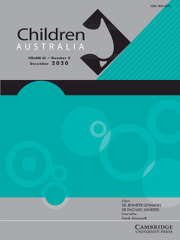No CrossRef data available.
Article contents
Should parents shiver?
Published online by Cambridge University Press: 29 February 2016
Abstract
According to at least one author, our lives are increasingly dominated by a ‘culture of fear’, in which possible adverse outcomes dominate our world views. Throughout the Western world, awareness of child sexual abuse has led to action by members of the public to draw attention to horrific crimes against children. This article reviews some of the media reports and seeks to explain why so many are concerned by those that prey on children.
- Type
- Not the last word: point and counterpoint
- Information
- Copyright
- Copyright © Cambridge University Press 1997
References
Bowcott, O. & Clouston, E.
1997, ‘Nightmare on any street’, The Guardian, 10 June, G2, pp. 1–3.Google Scholar
Coddington, D.
1997, The Australian Paedophile and Sex Offender Index, Sydney: Coddington, PSI Index.Google Scholar
Daily Telegraph Correspondent
1997, ‘Tolice right to warn of paedophiles, say judges’, The Daily Telegraph, 11 July, p. 12.Google Scholar
Furedi, F.
1997, Culture of Fear: Risk Taking and the Morality of Law Expectation, London, Cassell.Google Scholar
Goddard, C.R.
1993, ‘The courts fail the small victims of big crimes’, The Sunday Age, 7 March, p. 17.Google Scholar
Jackson, L.
1997, ‘Child molesters granted legal aid to sue police’, The Sunday Telegraph, 8 June, p. 1.Google Scholar
Lee, A. & Jenkins, L.
1997, ‘Court backs police over identifying paedophiles’, The Times, 11 July, p. 9.Google Scholar
Lewis, C.L.
1996, ‘The Jacob Wetterling Crimes Against Children and Sexually Violent Offender Registration Act: An unconstitutional deprivation of the right to privacy and substantive due process’, Harvard Civil Rights - Civil Liberties Law Review, 31(1): 89–118.Google Scholar
Teasdale, J.
1997, ‘Taedophile Seddon set for release’, The Liverpool Echo, June 17, p. 1.Google Scholar
Younge, G.
1997, ‘Exposing the guilty is a public service’, The Guardian, 10 June, G2, p. 3.Google Scholar


